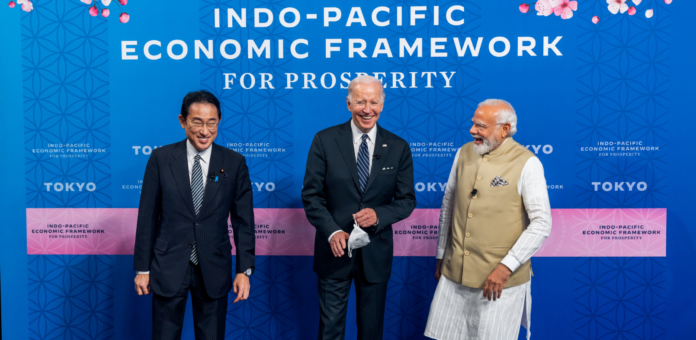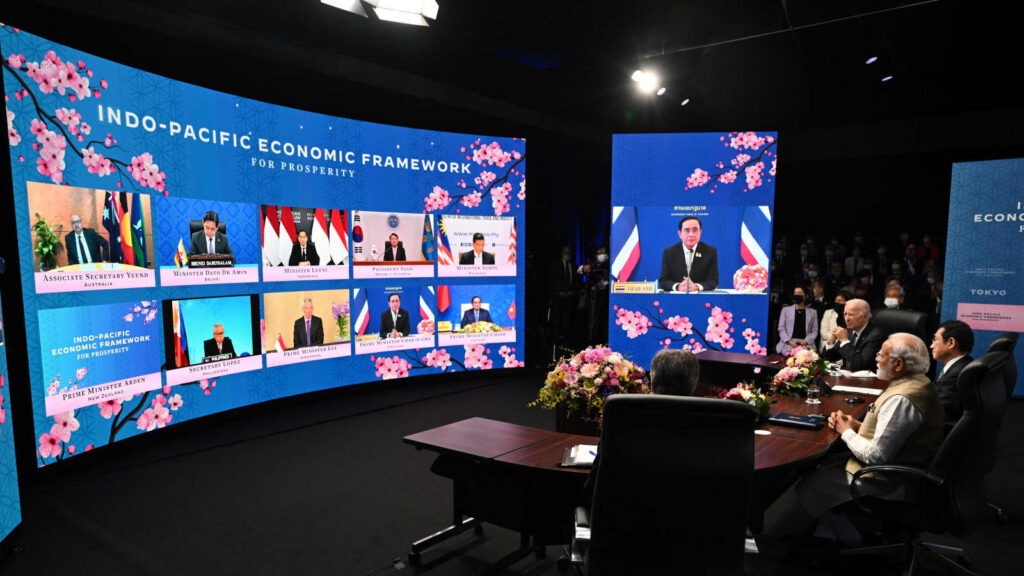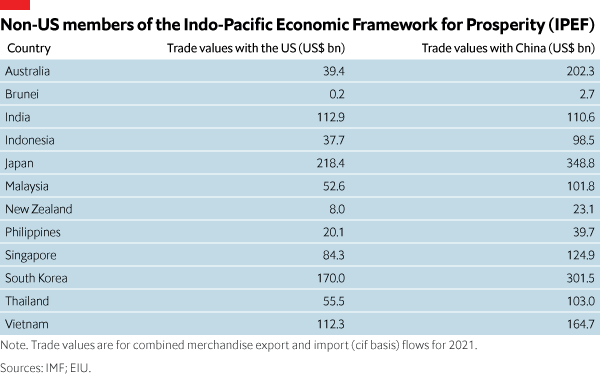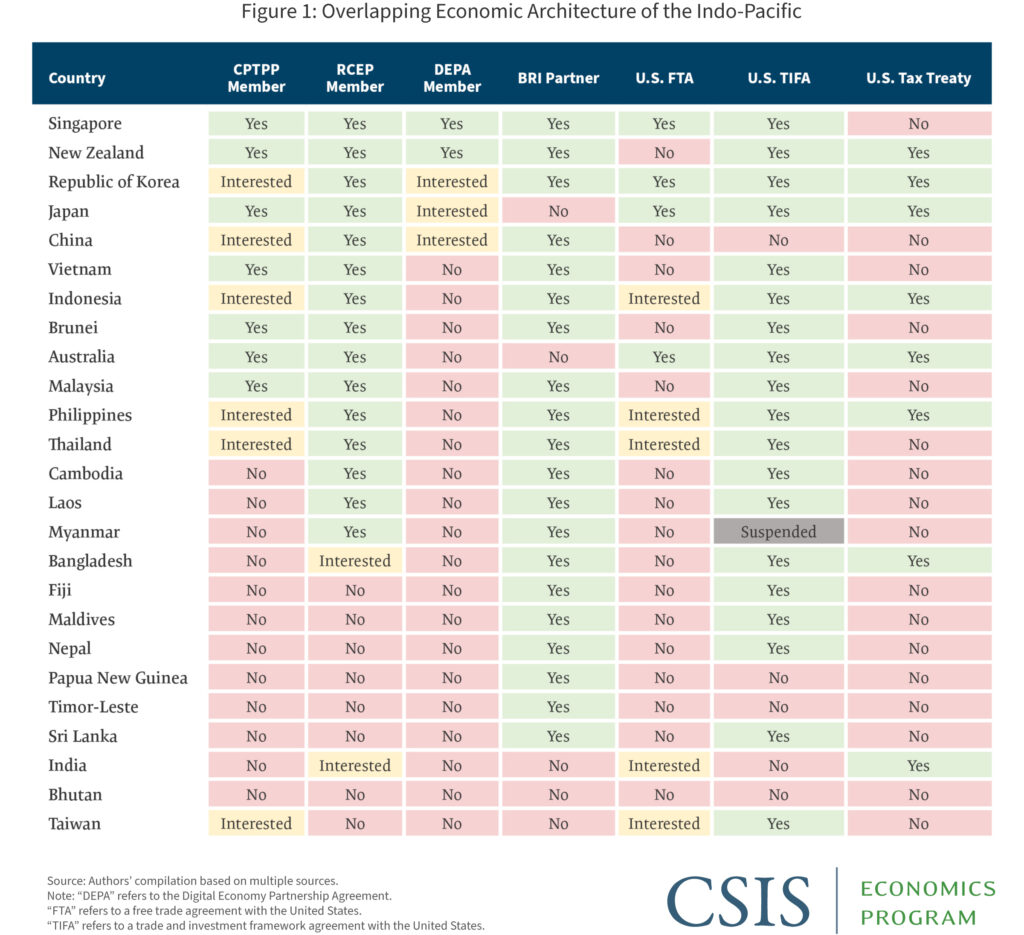
On May 23, U.S. President Joe Biden, Japanese Prime Minister Fumio Kishida, and Indian Prime Minister Narendra Modi held the launch of the Indo-Pacific Economic Framework for Prosperity (IPEF) at the Izumi Garden Gallery in Roppongi, Tokyo, with the leaders or ministerial officials of the other initial member countries participating via video. The IPEF is the centerpiece of Biden’s agenda for his trip to Asia.
The U.S. White House announced that this latest economic vision for the Asia-Pacific region includes 13 initial members, accounting for 40 percent of the world’s GDP.

In addition to the United States, the other 12 initial members are Australia, Brunei, India, Indonesia, Japan, South Korea, Malaysia, New Zealand, the Philippines, Singapore, Thailand, and Vietnam. At the end of the ceremony, two reporters on the sidelines repeatedly asked Biden “why Taiwan was not included”, but Biden ignored the question.
According to the U.S. government, the IPEF will help U.S. and Asian economies work more closely together on issues such as supply chains, digital trade, clean energy, worker protection, and anti-corruption efforts. The framework’s “four pillars” have long been announced, but the details still need to be negotiated among member countries, so it’s hard to say how the agreement will fulfill Biden’s promise to “help American workers and businesses” while also better meeting global needs. As previously reported in the media, member countries can join them flexibly and selectively, without having to sign up to all the pillars. A U.S. official told the Financial Times that member countries have two weeks to consider joining a few of the four pillars.

The Associated Press said the IPEF does not offer preferential terms for U.S. market access and no commitments on tariffs due to protectionist sentiment in the United States, so its appeal is in doubt. Member countries hardly see the benefit of emerging economies in Southeast Asia joining IPEF as it has no tariff cuts and does not (provide better) access to the U.S. market.
It was previously reported in the media that India had concerns about some elements of the IPEF, but the U.S. valued India’s accession, promising it “more flexibility in the way it joins. It is not clear what compromise was reached between India and the United States.
US media: IPEF lacks attractiveness
According to the Associated Press, the Biden administration-led “Indo-Pacific Economic Framework” aims to fill the strategic gap caused by the Trump administration’s withdrawal from the “Trans-Pacific Partnership” (TPP). However, the real attractiveness of the framework has been questioned due to the lack of practical elements such as market access.
CNN describes IPEF as not a trade agreement in the traditional sense. CNN recalls that the Biden administration has struggled to convince other countries to join — even staunch allies such as Japan and South Korea, not to mention some Southeast Asian countries that have less close ties to the U.S. Critics of the IPEF say the framework lacks any incentives — such as lower tariffs to attract other countries to join. Biden’s aides say the framework itself provides an attractive opportunity for participating countries to work closely with the United States, and that its announcement represents only the beginning of the overall plan.
Although the launch of IPEF is a high-profile demonstration of the U.S. government’s determination to become more involved in the Asian economy, the lack of some concrete and practical benefits and promises has led to a relatively lukewarm response from some countries.
Matthew Goodman, senior vice president for economic research at the Center for Strategic and International Studies (CSIS), a leading U.S. foreign policy think tank, believes that some signatories to the IPEF will be disappointed because the agreement will not include help for their access to Asia. Because the agreement will not include preferential terms to help them enter the U.S. market.
In addition, David Dodwell, executive director of the Hong Kong-APEC Trade Policy Group, wrote in the South China Morning Post that Asian leaders have two key demands: they do not want to be forced to choose sides between the United States and China, and they want to reach agreements on trade and investment access to the U.S. market. However, he believes this framework will hardly provide much substance due to the political consensus on the U.S. side to contain China and the U.S. reluctance to open the U.S. market to Asian products.
Dodwell believes that the Asian region already has bilateral economic and trade agreements such as APEC, ASEAN, and CPTPP, and it is difficult to say what new content the new, vaguely defined U.S. framework will bring.

Moreover, the United States can not exclude China. U.S. Trade Representative Dyche told the media on the 20th that the framework is designed to counter China’s influence in the region. Dodwell said China has become the world’s largest foreign investor, and it is also the largest market for most of Asia, with almost all of the region’s supply chains including China. If the Biden administration and their economic framework intentionally do not engage with China, then their strategy of returning to Asia is doomed to failure.
Liu Zongyi, senior fellow and secretary general of the South Asia and China Center, Shanghai Institutes for International Studies, pointed out that the focus of IPEC is on standards and rule-making. The biggest difference between IPEC and TPP is that IPEF will not facilitate market access for other countries by eliminating tariffs and non-tariff barriers to trade, which is the main reason why Asia-Pacific countries want to sign free trade agreements with the United States. Not only does the U.S. not want to provide more market access to Asian countries, but it also wants to undermine the burgeoning economic integration process in Asia.
Trying to isolate China is unrealistic
In response to the official announcement of the launch of the Indo-Pacific Economic Framework, China’s Foreign Ministry spokesman Wang Wenbin said that China, like regional countries, welcomes initiatives that are conducive to strengthening regional cooperation, but opposes attempts to create division and confrontation. China believes that regional cooperation frameworks, under whatever name, should promote free trade, should not engage in protectionism in disguise, should contribute to the recovery of the world economy, should not destabilize industrial chains, should promote open cooperation, and should not create geopolitical confrontation. The U.S. side should act following the rules of free trade, rather than start another stove, another set, impacting the existing regional cooperation structure and driving backward regional integration.
Wang Wenbin pointed out that the U.S. is politicizing, weaponizing, and ideologizing economic issues and using economic means to coerce regional countries to choose sides between China and the U.S. The U.S. side owes regional countries a statement. Artificially creating economic decoupling, technology blockade, industrial disconnection, and aggravating the supply chain crisis will only bring serious consequences to the world, and the United States cannot be an exception.
The U.S. side should know its mistakes and correct them, not make them again and again. The code for success in the Asia-Pacific is win-win cooperation, not zero-sum confrontation. The Asia-Pacific should become a highland for peaceful development, not a geopolitical dueling ground. Attempts to campify, NATOize, and cold-warize the Asia-Pacific are unlikely to succeed. Attempts to take a framework of any kind to isolate China will only end up isolating themselves.
(Source: CNBC, Economist Intelligence Unit, CSIS)



